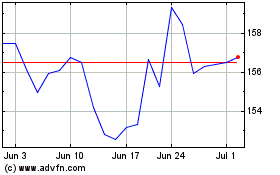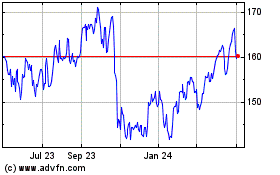Chevron-Led Group Bets More on Oil Field -- WSJ
May 26 2016 - 3:03AM
Dow Jones News
By Simon Clark in Astana and Selina Williams in London
ASTANA, Kazakhstan -- Chevron Corp. and its partners agreed to
invest up to another $37 billion to increase output at a Kazakhstan
oil field that is among the world's most expensive, the country's
energy minister said on Wednesday, a rare big spending commitment
during a prolonged crude price slump.
The investment in the oil field known as Tengiz would begin in
2017 and come on top of the about $37 billion already spent by
Chevron, the field's operator, and its partners: state-owned energy
firm, KazMunaiGas, Exxon Mobil Corp. and Russia's Lukoil.
Chevron Chief Executive John Watson was recently in Kazakhstan
and discussed the project with the nation's political leaders, said
Kanat Bozumbayev, the country's energy minister, in an interview.
The new investment is expected to produce 24,000 jobs in
Kazakhstan, he said.
"For us it's good news," Mr. Bozumbayev said. "This future
growth project is very important for us."
Chevron said the consortium would announce the final investment
decision for Tengiz at an appropriate time, adding a "rigorous
review of the future growth project is ongoing."
The investment is among a handful of large outlays by major oil
companies during a nearly two-year long slump in crude prices.
Companies have been forced to delay or cancel about $270 billion in
projects through March since oil prices began their long slide,
according to consultants Rystad Energy, including expensive Arctic
developments.
Chevron has lowered its spending as its revenues and profits
take a beating, including disclosing in 2014 a delay in its
expansion plans for Tengiz. The company estimated its overall
capital spending will range between $17 billion and $22 billion
annually over the next two years -- down from this year's between
$25 billion and $28 billion budget.
The project is vital for Kazakhstan, which depends on oil for
about half its state revenue. The economy of the Central Asian
state has suffered as oil prices have more than halved since a peak
in mid-2014. The IMF forecast gross domestic product growth of just
0.1% this year compared with 6% in 2013 before oil prices started
falling.
Tengiz's output is currently about 500,000 barrels a day, and
the expansion would boost its output to about 760,000 barrels a day
by 2021. Overall, Kazakhstan pumps about 1.6 million barrels a day,
which is forecast to decline without help from expanding
Tengiz.
The country's other huge oil project -- Kashagan -- has yet to
start up after gas leaks in 2013 shut down the oil field while it
was being commissioned. Mr. Bozumbayev said that the pipes and
plant at Kashagan were being inspected and the field is due to
start up in the fourth quarter of this year, maybe even as soon as
October. That $50 billion project was due to start pumping in 2005
but it was shut down amid budget blowouts, engineering missteps and
management disputes.
Both Tengiz and Kashagan are among the most expensive oil
projects in the world because of their size and the fact that their
oil involves toxic gas that requires extra facilities to extract
sulfur. They are in remote locations where infrastructure had to be
built.
When Chevron first signed a deal to develop Tengiz with the
Kazakh government in 1993, it was unclear how the oil would be
shipped from the region that borders Russia on one side and China
on the other.
For years, the companies involved in the Tengiz development trod
a delicate path between competing interests in the region vying for
control of export routes. By 2001, the companies claimed a victory
when oil started to flow through a newly constructed pipeline link
of over 900 miles from Kazakhstan through southern Russia to the
Black Sea port of Novorossiisk.
Jefferies senior oil equity analyst Jason Gammel said the
expansion of Tengiz could give Chevron a competitive advantage over
its rivals as it demonstrates a clear plan for oil production
growth beyond 2019, something the other firms are mostly
lacking.
"Tengiz is material in terms of size and it's the most visible
component of Chevron's growth beyond 2019," Mr. Gammel said.
Write to Simon Clark at simon.clark@wsj.com and Selina Williams
at selina.williams@wsj.com
(END) Dow Jones Newswires
May 26, 2016 02:48 ET (06:48 GMT)
Copyright (c) 2016 Dow Jones & Company, Inc.
Chevron (NYSE:CVX)
Historical Stock Chart
From Mar 2024 to Apr 2024

Chevron (NYSE:CVX)
Historical Stock Chart
From Apr 2023 to Apr 2024
